Side note: While ice machines come in countertop, freestanding and built-in options, our review below only covers countertop/portable models as they’re more readily available to everyone.
On this page:
Best ice makers to buy in 2023
We’ve rounded up some of the best countertop ice makers to buy based on features, price, and positive online reviews:
- Advwin 12kg Portable Ice Maker (Black): $129 RRP*
- Kogan 12kg Ice Cube Maker & Water Dispenser (Stainless Steel): $159 RRP*
- Maxkon 2L Ice Maker: $169.95 RRP*
- Devanti 2.2L Ice Maker: $249 RRP*
- Morphy Richards 2.8L Ice Maker: $325 RRP*
Advwin 12kg Portable Ice Maker (Black) − $129*
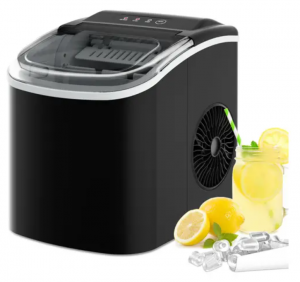
Bring out the big guns at your next party and ice on demand, with this Advwin portable ice maker that can make about 12kg of ice in only 24 hours, or nine bullet-shaped ice cubes every six minutes to be exact – more than enough for Christmas parties and family barbecues. It’s also super easy to use – just add the recommended amount of water, press the power button, and let the ice-making begin. It has an LED control panel with an automatic alarm, an ‘ice full’ light indicator, a viewing window, and a removable ice basket. This Advwin ice maker also comes with a self-cleaning system, its own ice scoop, an ice basket and drainage.
Kogan 12kg Ice Cube Maker & Water Dispenser (Stainless Steel) − $159*
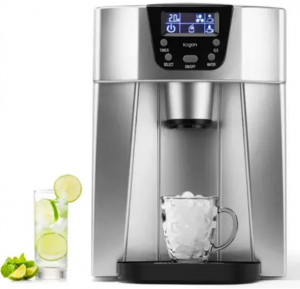
Don’t spend money buying an ice maker and water dispenser separately when you can have both in one, with this 2-in-1 countertop jewel from Kogan. This nifty appliance can freeze up to 12kg of ice over 24 hours, and dispenses chilled water on demand. It can churn out up to nine ice cubes every six minutes, or you can produce lots of small ice in less time. This model offers two convenient bullet-shaped ice cube sizes, an LCD screen with set timers, automatic water shortage and ‘full ice’ sensors, and a 0.6kg ice bin capacity.
Maxkon 2L Ice Maker − $169.95*
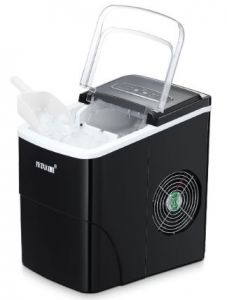
This Maxkon ice machine is lightweight and super easy to use, perfect for camping trips or office set-ups. It can produce nine bullet-shaped ice cubes every six to 13 minutes or up to 12kg of ice in a day. You can choose between two different ice sizes (small and large) and watch the magic happen via the see-through lid. The operation is pretty simple − plug it to power, add water into the built-in water tank until you reach the maximum level line, select your ice size and press the ON/OFF button on the LCD screen. This model comes with an 0.7kg ice basket capacity.
Devanti 2.2L Ice Maker − $249*
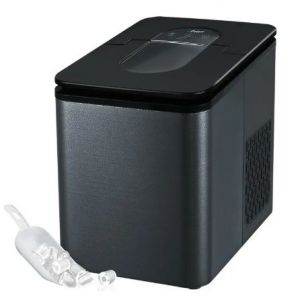
This nifty countertop Devanti 2.2L ice maker features a sleek design to suit most modern homes or restaurants. It can make nine bullet-shaped ice cubes every eight minutes depending on the water and ambient temperatures. This is the equivalent of up to 12kg of ice over 24 hours. Just fill up the appliance with water, turn it on, and voila! This model features an LED control panel with ‘ice full’ and low water level indicators, a viewing window, a large heat dissipation fan, a water drainage plug, and non-slip feet. This Devanti ice maker is suitable for home and commercial use. An ice scoop is included.
Morphy Richards 2.8L Ice Maker − $325*
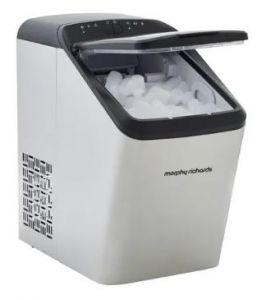
This smaller capacity 2.8L Morphy Richards ice maker (MRICE15SS) is your ideal countertop companion for making ice at a moment’s notice. It can churn out nine ice cubes in as little as seven minutes or 14kg of ice every 24 hours. It can make cylinder-shaped ice in two sizes and has a 1.8kg ice bin storage capacity, big enough for a personal supply or to entertain at home. This model also features an easy-to-use control panel that lets you know when the ice box is full or if you need to top up the water, a large viewing window, and your standard accessories including an ice basket and ice scoop. This model doesn’t come with a drainage plug.
How long do ice makers take to make ice?
Most ice makers can make small batches of ice in under 10 minutes and 12kg-15kg of ice in about 24 hours, which is not too shabby. Ice processing times will vary between models, brands, and power outputs (100W-150W). Just keep in mind that your ice maker will take longer to get its first batch of ice out as the appliance will need time to reach the proper temperature to begin freezing the ice. Once your ice maker has reached the optimum temperate it will churn out ice very quickly.
How much do ice makers cost?
Ice machines can cost anywhere from $300 to $7,000 depending on the size, capacity, brand, whether they’re for personal or commercial use, etc. If you’re on a budget, check out online retailers and third-party sellers like Kogan, Amazon, eBay, and Catch.com.au. Brands like Devanti, Morphy Richards, and Maxkon are worth considering for affordable ice makers.
What to look out for when buying an ice maker
If you’re seriously considering buying an ice machine for your home, you need to know what to look out for before you settle on a purchase or you risk bypassing a cool buy for a lemon. Here are the main features to look out for when shopping for an ice maker:
- Type of ice maker: Ice makers come in all shapes and sizes – the most common types (and the cheapest) of ice machines are countertop models, but there are also undercounter and freestanding ice makers with bigger capacities (and bigger price tags).
- Ice production (ice-making capacity): Most ice makers can produce 100g-200g of ice in as little as six minutes or more than 10kg of ice in under 24 hours, while some models may take longer. Consider the speed of ice production and volume together.
- Ice selection: Choose an ice maker that can make different-sized ice cubes for iced coffee, drinks, smoothies, snow cones, to keep foods cold on the go, etc. Most models make cylindrical ice as it’s easier to make and more versatile than cubed ice.
- Storage capacity: If you like to entertain or just need ice for special occasions, consider an ice maker with a large enough capacity to accommodate multiple people. Ice bin/basket capacities range from 0.7kg to 2kg for countertop appliances, and go up to 5kg-7kg for freestanding models. Keep in mind we’re talking about storage bin capacity here, NOT to be confused with ice-making capacity (how much ice can be made in any 24-hour period) or water capacity (how much water is needed to make ice).
- Drainage: Most countertop and freestanding ice makers require a drainage line or plug to dispose of the melted ice, while some might recycle that melted ice to make more ice cubes. Be sure to check.
What’s the difference between an ice maker & ice machine?
Broadly speaking, there’s no difference between an ice maker and an ice machine. Both terms are interchangeable and refer to a standalone domestic or industrial appliance that makes ice on demand. However, if we’re getting into the semantics, most people also refer to the part of their refrigerator that makes ice (usually near the water dispenser) as an ice maker and refer to commercial standalone appliances that make ice as an ice machine. In the end, it’s all the same – you get ice on demand.
Read more: Fridges with ice makers & water dispensers
Do ice makers need a drain?
Yes, most ice makers come with a built-in drainage plug or drain line to get rid of any excess water left over from the ice-making process and for when the ice melts. Ice machines produce a fair bit of wastewater, including condensation from the compressor. However, some models feed the melted ice back into the ice maker to be refrozen, while more sophisticated ice makers double as a mini freezer to keep the ice frozen and therefore don’t require a drain line.
Are ice makers worth it?
An ice maker can be worth its weight in gold if you’re looking to free up some freezer space, like to entertain at home, or simply want to ensure you won’t run out of ice at Christmas when shops are closed. However, if the ice cube trays in your fridge are enough for your needs and you prefer to buy ice by the bag, then an ice maker may not be worth the expense.
*Prices taken from respective retailers, correct as of January 2023.





Share this article